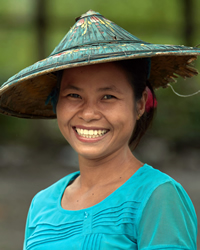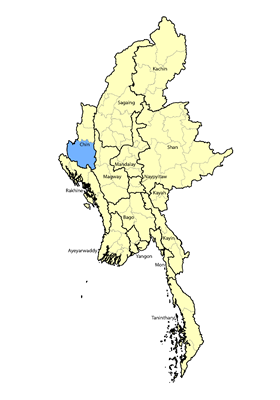The Panam are a newly discovered tribe with their own dialect or language. Although they are considered part of the broad Chin group of peoples, none of the more than 60 tribes in that cluster uses the name “Chin” to describe themselves in their own language. Historians disagree about the meaning of the label “Chin.” Some claim it was a Burmese word meaning “basket,” while others say it means “friend.” After the British seized control of the region in the 19th century, they usually spelled the name of these groups “Khlang” or “Khyang,” which later morphed into “Chin.”
Location: Inhabiting a tiny area with just two villages (Tar Yar Kone and Kyauk Pa Lin) in western Chin State's Paletwa Township, the 1,000 members of the Panam tribe live just 11 miles (18 km) from the Bangladesh border, near the juncture where Myanmar, Bangladesh, and India meet. In recent years, Paletwa and other border districts have seen hundreds of thousands of refugees cross into Bangladesh as they flee the chaotic civil war engulfing Myanmar. Few people have ever heard of the Panam people, whose small territory is surrounded on every side by the large Khumi tribe, with densely-populated Rakhine communities also located nearby.
Language: Little is known about the Panam vernacular and how it relates to the dozens of other Tibeto-Burman languages spoken in the mountains of western Myanmar. Because of their proximity to Khumi speakers, Panam may be related to that language.
The Panam homeland of Paletwa Township enjoyed a relatively peaceful existence until the last several years, when the civil war brought great change to the area. The war has resulted in the deaths of many people, both civilians and soldiers who either willingly signed up to fight or were forcibly enlisted. A short distance south of the Panam territory, in northern Rakhine State, anti-government forces finally ended the Burmese junta's control of the area. In December 2024, the Arakan Army seized control of the entire 70-mile (270-km) border with Bangladesh from the humiliated Myanmar forces.
The tribes in this part of Myanmar have always relied on village chiefs and elders to lead them. A local Chin historian wrote: “Each village has its own government, and chiefs and headmen function as administrators for the village…. Hereditary chieftainships were common in the northern part of Chin State, whereas in the southern part a headman or a village leader ruled the village. In some instances, chiefs ruled over several villages.”
Since time immemorial, the Panam people worshipped a hierarchy of spirits as they sought to make sense of the world around them. After Christianity was introduced, it initially encountered a difficult period before taking root among the people. Reflecting on the radical transformation that swept Chin State, it was said: “The teachings of the missions awakened the people to defects in their social life. They realized that religious rituals and sacrifices to the spirits were very much a waste.”
Today, a strong majority of Panam people are followers of Jesus Christ, with only a minority continuing to cling to the animistic practices of their forefathers. Because the Panam have previously never appeared on any Christian lists of Myanmar's people groups or languages, no Scripture, video, or audio resources have ever been translated into their language. Panam believers probably use either Burmese or Khumi Bibles in their meetings.
Scripture Prayers for the Panam in Myanmar (Burma).
| Profile Source: Asia Harvest |











